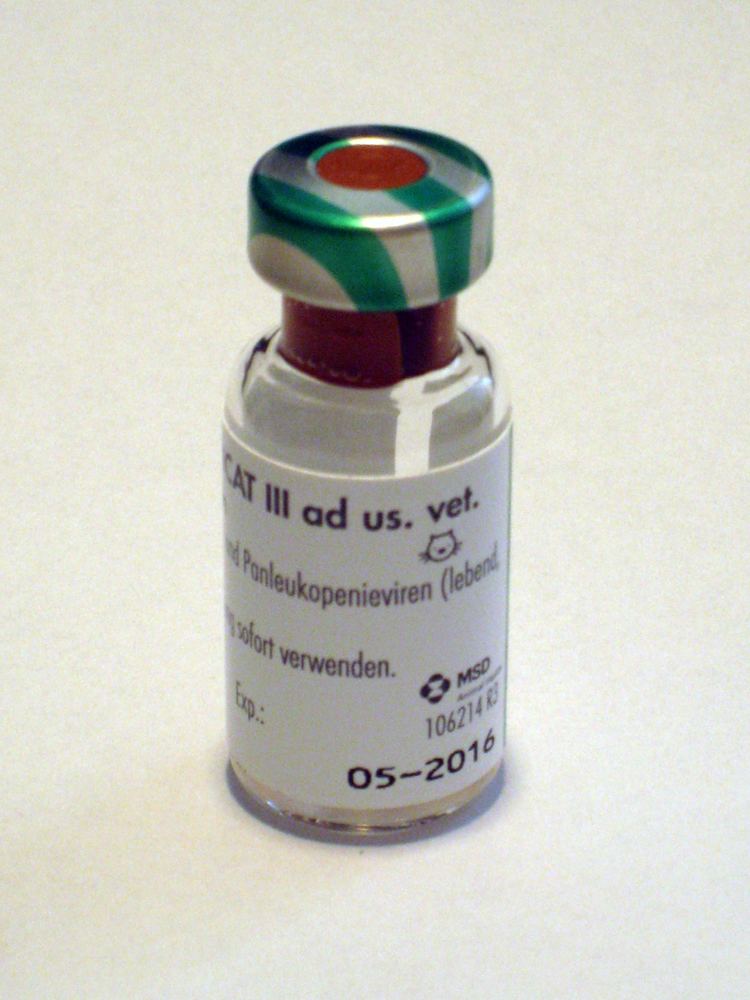 | ||
Programs supporting regular feline vaccination have contributed both to the health of cats and to public health.
Contents
- Recommended administration of vaccines
- General schedule
- Type
- Frequency
- Method
- Location
- Core vaccines
- Rabies disputed
- FVR or FHV 1FCVFPV
- Non core vaccines
- Not recommended vaccines
- Controversy
- Adverse reactions
- References
Currently, there are geographically defined core vaccines and individually chosen non-core vaccine recommendations for cats. A number of controversies surrounding adverse reactions to vaccines have resulted in authorities revising their guidelines for feline vaccination.
Recommended administration of vaccines
In 2006 and 2010, revised guidelines addressed concerns about adverse vaccine reactions by altering the recommended frequency, type, methods, and locations for administration of core and non-core cat vaccines.
General schedule
Most vaccination protocols recommend a series of vaccines for kittens, with vaccine boosters given at one year of age. Frequency of vaccination thereafter varies depending on the lifestyle of the individual cat, including:
Because these factors may change over time, many professional organizations recommend routine annual examinations, where a vaccination plan for each individual feline can be decided during a discussion between the veterinarian and cat owner.
Type
In their 2010 recommendations, WSAVA (World Small Animal Veterinary Association) emphasized the importance of administering non-adjuvanted vaccines whenever possible, as vaccines that included these immune-stimulating agents were shown to increase adverse vaccine reactions in pets.
Frequency
WSAVA also prefers serological testing over unnecessary boosters or re-vaccination doses of core vaccines after the initial 12-month booster that follows the kitten series of modified live virus [MLV] vaccines. This is because core vaccines show an excellent correlation between the presence of antibody and protective immunity to a disease, and have a long DOI (Duration of Immunity). Antibody tests can be used to demonstrate the DOI after vaccination with core vaccines, though not for non-core vaccines.
Method
Most vaccines are given by subcutaneous (under the skin) or intramuscular (into the muscle) injection. Respiratory tract disease vaccination may be given intra-nasally (in the nose) in some cases.
Location
Many recent protocols indicate that vaccines should be given in specific areas in order to: ease identification of which vaccine caused an adverse reaction, and ease removal of any vaccine-associated sarcoma.
In North America, vets adopted the practice of injecting specific limbs as far from the body as possible, for example the rear right for rabies, rear left for leukemia, and others in the right front shoulder - being careful to avoid the midline or interscapular space.
This set of locations was not widely adopted outside of North America, and WSAVA's international group made new recommendations that vaccines be administered:
Core vaccines
Core vaccines are defined as those vaccines which all cats, regardless of circumstances, should receive. Core vaccines protect animals from severe, life-threatening diseases which have global distribution.
Rabies (disputed)
The latest (2006) North American recommendation still includes rabies in the core vaccines. Likewise, the National Association of State Public Health Veterinarians (NASPHV) in the U.S. gives detailed instructions on how to deal with what they describe as a serious public health problem, and includes a useful table, summarizing all the rabies vaccines sold in the U.S.
However, the 2010 international WSAVA recommendation generally considers the rabies vaccine a non-core vaccine, except in areas where the disease is endemic or where required by law.
FVR or FHV-1/FCV/FPV
In many locations, the rabies vaccine is accompanied by a single combined FVRCP vaccine shot which protects against Feline viral rhinotracheitis, calicivirus, and panleukopenia.
Non-core vaccines
Non-core vaccines are those that are required by only those animals whose geographical location, local environment or lifestyle places them at risk of contracting specific infections.
Not recommended vaccines
The following vaccines are not recommended due either to lack of evidence of effectiveness or to a high chance of adverse reaction.
Controversy
In recent years, vaccination has become a controversial topic among veterinarians and pet owners. Studies citing specific adverse reactions and general consequences for long-term health and immunity are both causing professional bodies to recommend reduced frequency in feline vaccination.
In 2010, the American Veterinary Medical Association (AVMA) and American Association of Feline Practitioners (AAFP) developed vaccination guidelines recommending that FVRCP vaccinations generally be administered every 3 years, after completion of the kitten series of shots (which is needed due to maternal antibody interference).
Internationally, the 2010 The World Small Animal Veterinary Association (WSAVA) vaccination guidelines reduce the number of vaccines which should be considered core for felines, as well as recommending less frequent vaccine administration.
However, in an open letter to WSAVA, an Australian pet owner and long-time consumer advocate has created a detailed critique of these guidelines, with numerous scholarly citations, arguing that the 3-year booster or re-vaccination recommendations are either arbitrary or influenced by vaccine manufacturers. She cites the scientific findings of both WSAVA's and other leading researchers, which indicate that, similar to humans, the duration of immunity (DOI) for cats vaccinated early in life with MLV (modified live viruses) is many years, if not the entirety of adulthood, despite the common practice of "boosting" vaccines every 1 to 3 years.
In the executive summary section, the WSAVA guidelines do argue against needless vaccination and in support of "the development and use of simple in-practice tests for determination of seroconversion (antibody) following vaccination." In addition, they also note that "Vaccines should not be given needlessly. Core vaccines should not be given any more frequently than every three years after the 12 month booster injection following the puppy/kitten series, because the duration of immunity (DOI) is many years and may be up to the lifetime of the pet." The open letter critique focuses on the less-nuanced summary of these recommendations in the Tables given for vaccination guidelines, which could imply that re-vaccination should occur every 3 years.
Adverse reactions
Vets and owners should also consider factors that have been shown to increase the risk of adverse vaccine reactions. Examples of such factors include:
